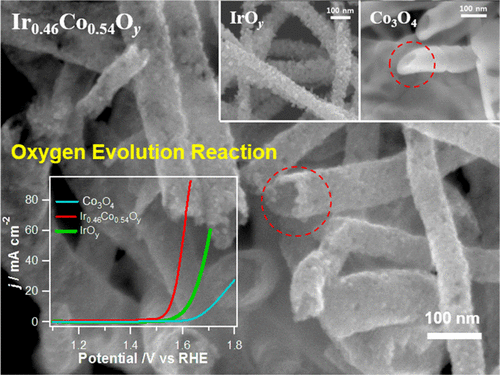当前位置:
X-MOL 学术
›
ACS Appl. Mater. Interfaces
›
论文详情
Our official English website, www.x-mol.net, welcomes your
feedback! (Note: you will need to create a separate account there.)
Nanotubular Iridium–Cobalt Mixed Oxide Crystalline Architectures Inherited from Cobalt Oxide for Highly Efficient Oxygen Evolution Reaction Catalysis
ACS Applied Materials & Interfaces ( IF 8.3 ) Pub Date : 2017-09-26 00:00:00 , DOI: 10.1021/acsami.7b12247 Areum Yu 1 , Chongmok Lee 1 , Myung Hwa Kim 1 , Youngmi Lee 1
ACS Applied Materials & Interfaces ( IF 8.3 ) Pub Date : 2017-09-26 00:00:00 , DOI: 10.1021/acsami.7b12247 Areum Yu 1 , Chongmok Lee 1 , Myung Hwa Kim 1 , Youngmi Lee 1
Affiliation

|
Here, we report the unique transformation of one-dimensional tubular mixed oxide nanocomposites of iridium (Ir) and cobalt (Co) denoted as IrxCo1–xOy, where x is the relative Ir atomic content to the overall metal content. The formation of a variety of IrxCo1–xOy (0 ≤ x ≤ 1) crystalline tubular nanocomposites was readily achieved by electrospinning and subsequent calcination process. Structural characterization clearly confirmed that IrxCo1–xOy polycrystalline nanocomposites had a tubular morphology consisting of Ir/IrO2 and Co3O4, where Ir, Co, and O were homogeneously distributed throughout the entire nanostructures. The facile formation of IrxCo1–xOy nanotubes was mainly ascribed to the inclination of Co3O4 to form the nanotubes during the calcination process, which could play a critical role in providing a template of tubular structure and facilitating the formation of IrO2 by being incorporated with Ir precursors. Furthermore, the electroactivity of obtained IrxCo1–xOy nanotubes was characterized for oxygen evolution reaction (OER) with rotating disk electrode voltammetry in 1 M NaOH aqueous solution. Among diverse IrxCo1–xOy, Ir0.46Co0.54Oy nanotubes showed the best OER activity (the least-positive onset potential, greatest current density, and low Tafel slope), which was even better than that of commercial Ir/C. The Ir0.46Co0.54Oy nanotubes also exhibited a high stability in alkaline electrolyte. Expensive Ir mixed with cheap Co at an optimum ratio showed a greater OER catalytic activity than pure Ir oxide, one of the most efficient OER catalysts.
中文翻译:

氧化钴继承的纳米管铱-钴混合氧化物晶体结构,用于高效氧释放反应催化
在这里,我们报告了铱(Ir)和钴(Co)的一维管状混合氧化物纳米复合材料的独特转变,表示为Ir x Co 1- x O y,其中x是相对于总金属含量的相对Ir原子含量。各种Ir中形成X钴1- X ø ý(0≤ X ≤1)结晶管状纳米复合材料容易通过电纺丝和随后的煅烧过程来实现的。结构表征清楚地证实了Ir x Co 1– x O y多晶纳米复合材料具有由Ir / IrO 2和Co 3 O 4组成的管状形态,其中Ir,Co和O均匀分布在整个纳米结构中。Ir x Co 1– x O y纳米管的容易形成主要归因于煅烧过程中Co 3 O 4的倾斜以形成纳米管,这可能在提供管状结构模板和促进形成中起关键作用。通过与Ir前驱体结合而产生IrO 2。此外,所获得的Ir x Co 1– x的电活性通过在1 M NaOH水溶液中用转盘电极伏安法测定O y纳米管的氧释放反应(OER)。在各种Ir x Co 1– x O y中,Ir 0.46 Co 0.54 O y纳米管显示出最佳的OER活性(正电势最小,最大电流密度和低Tafel斜率),甚至比商品Ir更好。 /C。Ir 0.46 Co 0.54 O y纳米管在碱性电解质中也表现出高稳定性。昂贵的Ir与廉价的Co以最佳比例混合后,比纯Ir氧化物(最有效的OER催化剂之一)显示出更高的OER催化活性。
更新日期:2017-09-26
中文翻译:

氧化钴继承的纳米管铱-钴混合氧化物晶体结构,用于高效氧释放反应催化
在这里,我们报告了铱(Ir)和钴(Co)的一维管状混合氧化物纳米复合材料的独特转变,表示为Ir x Co 1- x O y,其中x是相对于总金属含量的相对Ir原子含量。各种Ir中形成X钴1- X ø ý(0≤ X ≤1)结晶管状纳米复合材料容易通过电纺丝和随后的煅烧过程来实现的。结构表征清楚地证实了Ir x Co 1– x O y多晶纳米复合材料具有由Ir / IrO 2和Co 3 O 4组成的管状形态,其中Ir,Co和O均匀分布在整个纳米结构中。Ir x Co 1– x O y纳米管的容易形成主要归因于煅烧过程中Co 3 O 4的倾斜以形成纳米管,这可能在提供管状结构模板和促进形成中起关键作用。通过与Ir前驱体结合而产生IrO 2。此外,所获得的Ir x Co 1– x的电活性通过在1 M NaOH水溶液中用转盘电极伏安法测定O y纳米管的氧释放反应(OER)。在各种Ir x Co 1– x O y中,Ir 0.46 Co 0.54 O y纳米管显示出最佳的OER活性(正电势最小,最大电流密度和低Tafel斜率),甚至比商品Ir更好。 /C。Ir 0.46 Co 0.54 O y纳米管在碱性电解质中也表现出高稳定性。昂贵的Ir与廉价的Co以最佳比例混合后,比纯Ir氧化物(最有效的OER催化剂之一)显示出更高的OER催化活性。





















































 京公网安备 11010802027423号
京公网安备 11010802027423号